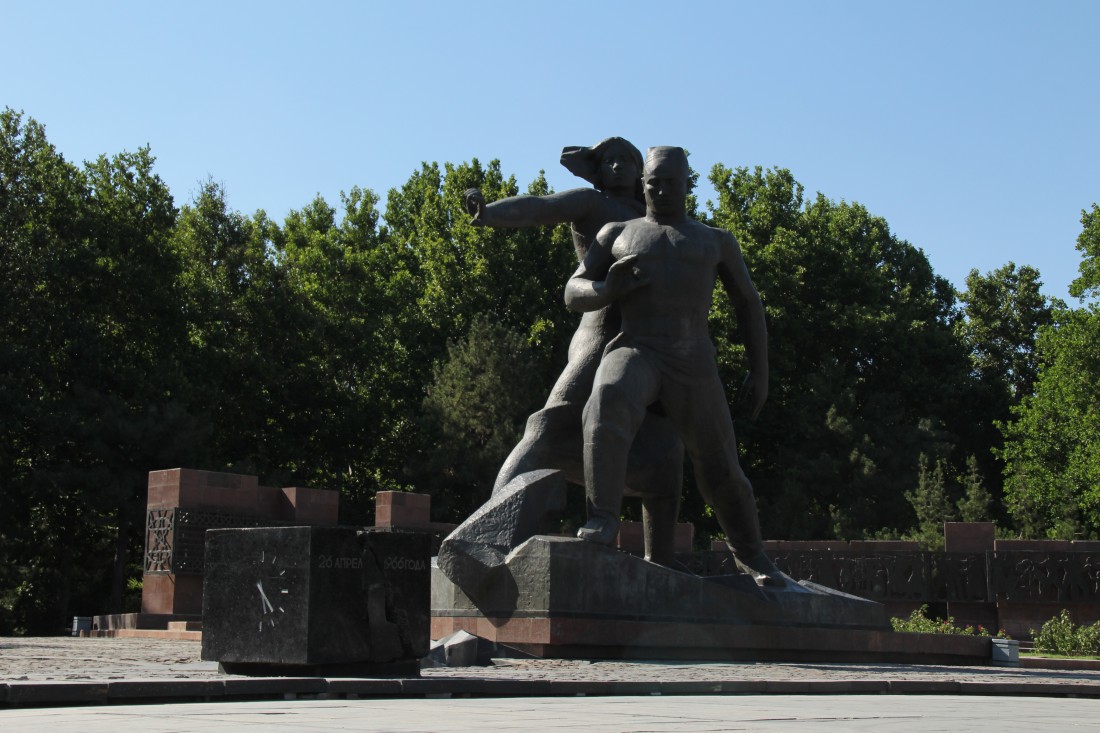Temporary difficulties have repeatedly overcome the Uzbek people. A striking example of this is the Tashkent earthquake, which occurred on April 26, 1966 at 05: 23 by local time.
The tragedy shocked the entire country. As a result of the earthquake, hundreds of homes were destroyed, and the center of Tashkent suffered the most. More than 300,000 people were left homeless and forced to live in tents. Thanks to the friendly assistance provided by the former Union republics, a grandiose project was implemented, within the framework of which almost the entire city was reconstructed, as well as new neighborhoods were built. In honor of this event, on May 20, 1976, the monument "Courage" was erected in Tashkent. The monument was created by the sculptor and artist Dmitry Ryabichev.

The main idea of the monument is friendship, fortitude and courage of people. The artistic image is represented by a black cube made of granite. It shows a dial with a clock, the date and year of the tragedy, through which the split passes, symbolizing the earthquake. The crack from the black cube leads to the image of a family. Here we see a woman holding a child with one hand and a man making a repulsive gesture.
Bas-reliefs complete the composition. They serve as a background for the monument and are arranged in a semicircle. On the bas-reliefs you can see courageous people who selflessly helped to restore the city.
The monument "Courage" is an important landmark of the city. Just-married come here with flowers, guests of the capital. Young and old people like to relax near the monument. The monument perfectly conveys the strength of the spirit and the hope that all temporary difficulties will be overcome.
Map
Working hours: 9:00 AM - 6:00 PM, Mon-Fri
For any questions
ПОЛЬЗОВАТЕЛЬСКОЕ СОГЛАШЕНИЕ
1. Определение
Настоящее Пользовательское соглашение (далее — Соглашение) является Публичной офертой в соответствии со статьёй 367 Гражданского кодекса Республики Узбекистан от 21.12.1995 (https://lex.uz/ru/docs/111181#162763) и регулирует порядок использования материалов и Сервисов сайта Государственного унитарного предприятия «Национальный PR-центр» (далее — Предприятие), размещённого на веб-сайте и поддоменах Национального Туристического Информационного Центра: https://uzbekistan.travel/ (далее — Сайт).
Посетитель и (или) Пользователь подтверждает, что ознакомлен, полностью и безоговорочно принимает все условия настоящего Соглашения и обязуется их соблюдать.
Использование Сайта Пользователем означает полное принятие данного Соглашения «как есть» в форме акцепта.
Соглашение вступает в силу с момента посещения любой страницы Сайта и (или) регистрации на Сайте и действует бессрочно во время пользования Сервисами Сайта.
Настоящее Соглашение обязательно для исполнения всеми Посетителями и Пользователями без каких-либо изъятий и дополнительных согласований.
Пользователь обязуется самостоятельно проверять актуальную редакцию Соглашения на Сайте перед использованием Сервисов.
2. Предмет Соглашения
Предметом настоящего Соглашения являются правила использования материалов Сайта и предоставление Посетителю и (или) Пользователю возможности использования Сервисов Сайта.
Предприятие является правообладателем исключительных прав на Сайт в целом и на его составные части, включая все виды контента: логотипы, товарные знаки, тексты, статьи, аннотации, иллюстрации, фотографии, графику, аудио- и видеофайлы, пользовательские интерфейсы, дизайн, структуру, программы, базы данных.
Я прочитал(а) и соглашаюсь с условиями использования сайта и политикой конфиденциальности.
